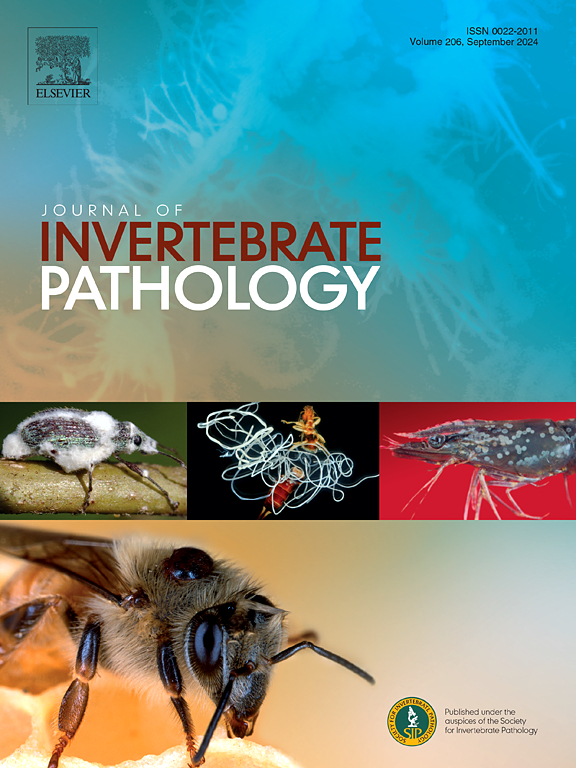小孢子虫(Ameson portunus)孢子质形态、蛋白质组学和代谢组学特征。
IF 2.4
3区 生物学
Q1 ZOOLOGY
引用次数: 0
摘要
感染性孢子体是小孢子虫细胞内生存和繁殖的第一个阶段,但目前对其生物学特性的认识还很缺乏。在本研究中,我们成功地在离体条件下萌发了Ameson portunus,并首次成功地分离纯化了这种水生小孢子虫的孢子质。形态学观察表明,孢子质呈球形,不折射,大小与成熟孢子相似。进一步的超微结构观察表明,孢子质被单一的膜包裹,有一个核,它们的细胞质覆盖着一个单核细胞核,是相对颗粒状和均匀的。孢子质和成熟孢子的蛋白质组学和代谢组学比较分析表明,214个显著差异表达蛋白(DEPs)和198个显著差异表达代谢物(dem)可能参与孢子萌发过程。一些参与糖酵解、戊糖磷酸途径、氨基酰基- trna合成、核苷酸代谢和核糖体途径的DEPs在孢子质体中上调。特别地,几种转运蛋白的表达在孢子质体中也显著增加。相应的,参与氨基酰基- trna合成、核苷酸代谢和氨基酸生物合成途径的部分dem下调。综上所述,我们的研究结果表明,在体外产生的麻豆芽孢体中,能量、核苷酸和蛋白质的合成等重要代谢活动已经开始,为寄生虫从休眠阶段过渡到活跃的感染阶段做准备。本文章由计算机程序翻译,如有差异,请以英文原文为准。

Morphology, proteome and metabolome characterization of the sporoplasm of Ameson portunus (Microsporidia)
Infective sporoplasms are the first stage of intracellular survival and propagation for Microsporidia, yet there is a paucity of knowledge regarding their biological characteristics. In this study, we successfully germinated Ameson portunus in vitro, and for the first time, we successfully isolated and purified the sporoplasm of this aquatic microsporidian. Morphological observations show that sporoplasms are spherical, non-refractive, and are similar in size to mature spores. Further ultrastructural observations show that sporoplasms are enclosed by a single membrane, with a single nucleus, their cytoplasm covering a monokaryotic nucleus is relatively granular and homogeneous. Comparative proteomic and metabolomic analyses of sporoplasms and mature spores suggest that 214 significantly differentially expressed proteins (DEPs) and 198 significantly differentially expressed metabolites (DEMs) are possibly involved in the spore germination processes. Several DEPs involved in glycolysis, the pentose phosphate pathway, aminoacyl-tRNA synthesis, nucleotide metabolism and ribosome pathways were upregulated in sporoplasms. Specially, the expression of several transporter proteins was also significantly increased in sporoplasms. Correspondingly, some DEMs involved in aminoacyl-tRNA synthesis, nucleotide metabolism, and amino acid biosynthesis pathways were downregulated. Collectively, our results indicate that significant metabolic activities, including energy and nucletotide and protein synthesis have been initiated in the in vitro produced sporoplasms of A. portunus to prepare for the transition of the parasites from the dormant stage to the active infective stage.
求助全文
通过发布文献求助,成功后即可免费获取论文全文。
去求助
来源期刊
CiteScore
6.10
自引率
5.90%
发文量
94
审稿时长
1 months
期刊介绍:
The Journal of Invertebrate Pathology presents original research articles and notes on the induction and pathogenesis of diseases of invertebrates, including the suppression of diseases in beneficial species, and the use of diseases in controlling undesirable species. In addition, the journal publishes the results of physiological, morphological, genetic, immunological and ecological studies as related to the etiologic agents of diseases of invertebrates.
The Journal of Invertebrate Pathology is the adopted journal of the Society for Invertebrate Pathology, and is available to SIP members at a special reduced price.

 求助内容:
求助内容: 应助结果提醒方式:
应助结果提醒方式:


